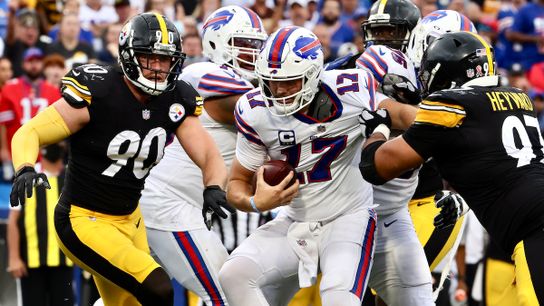ORCHARD PARK, N.Y. -- For the past several years, Steelers defensive coordinator Keith Butler has stressed that ideally he'd like to blitz less and play coverage on the back end more because blitzing leaves defenders on an island on the back end.
But despite his desire to play that way, the Steelers have continued to be a team that blitzes one of the highest percentages in the NFL.
Last season, for example, the Steelers blitzed 40.3 percent of the time, third-highest in the NFL behind the Ravens and Dolphins according to Pro Football Reference. In 2019, that percentage was 36.9 percent of the time, again in the top 10 in the league.
In Sunday's 23-16 season-opening win over the Bills, however, the Steelers checked their blitz at the door. According to NFL NextGen stats, the Steelers blitzed just twice on 54 pass attempts by Buffalo.
Despite that, they still sacked quarterback Josh Allen three times and hit him eight times. And they did it largely by rushing just four players -- though Bills head coach Sean McDermott would dispute even that.
"That, or they rushed three at times,” McDermott said.
Point is, the Steelers got pressure with just their front four. In fact, according to CBS Sports, defensive tackle Cam Heyward led the NFL in Week 1 with 12 quarterback pressures. Outside linebackers T.J. Watt and Melvin Ingram were tied for third-most pressures in Week 1 with eight each.
That's 28 quarterback pressures out of three guys, all of whom were playing in a rotation up front with other players. While Heyward was on the field most of the time, he was spelled at times. Watt and Ingram played in a rotation with second-year pro Alex Highsmith, with all three getting a pretty equal number of snaps.
It allowed the Steelers to stay fresh and continue to get after Allen.
"It’s huge," Heyward said. "We had something like that last year with Bud (Dupree) and Alex. To replicate that with a guy like Melvin Ingram, we’re pretty lucky. We don’t take that for granted. We’re dealing with some injuries with Stephon Tuitt. To have that rotation outside and then get guys like Chris Wormley and Tyson Alualu, (Isaiah) Buggs and Carlos (Davis), we’ve got a sound front to go along with it."
It also allowed the Steelers to play more coverage on the back end. Instead of sending five or even six players at Allen, the Steelers were capable of dropping seven players into coverage. That often left Allen with nowhere to go with the football.
It was the exact opposite plan from what they had when they played the Bills at Highmark Stadium last December in a 26-15 loss. In that game, the Steelers blitzed Allen 27 times on 44 drop backs, 61.3 percent of the time.
That allowed Allen to get the ball to No. 1 receiver Stefon Diggs, who had 10 catches for 130 yards, 66 of which came after the catch.
Sunday, Diggs had nine catches, which was not all that dissimilar from the catches he had last season. But he got next to nothing after the catch, gaining 69 yards, a 7.7 per catch average. His long catches was 13 yards.
"It was showing him different looks," said cornerback Cam Sutton of how the Steelers slowed Diggs, who led the NFL with 127 receptions for 1,535 yards a year ago.
"They did a great job of moving him around and some things. He caught some things, whether it was coverage based or finding some holes in zones. That’s the battle of the game, the chess match of the game. Some of those things, you play them for what they are, play the situations, tackle the catch, keep everything in front of you. Sometimes you’re able to challenge and get after those guys. We were able to limit him. Coming into the game, we knew how explosive he is. I feel like we did a pretty good job."
But it wasn't just Diggs who got little after the catch. Slot receiver Cole Beasley, who had 26 yards of his 41 receiving yards after the catch last December, had eight catches for 60 yards in this one, often getting tackled as he caught the ball. As a team, the Bills averaged 9.0 yards per reception and Allen was limited to 5.3 yards per pass attempt.
Part of that chess match was using rookie defensive back Tre Norwood as an interchangeable piece. Norwood, a seventh-round draft pick, played 80 percent of the defensive snaps, but he wasn't always in the same place. Sometimes he lined up in the slot. Others, he went to free safety and Minkah Fitzpatrick moved up and played the slot.
The Steelers also used Sutton in the slot at times, with James Pierre on the outside, while other times Arthur Maulet played the slot and Sutton stayed outside.
Figuring out who was going to be where so they could zero in an attack a perceived weakness was an issue for the Bills -- especially with so many players dropping into coverage because the Steelers didn't need to blitz with the pressure they were creating with their four-man rush.
Because of that, the Bills were forced to get rid of the ball quickly and try to get gains after the catch. And those yards just weren't there.
"You have to give credit where credit is due," McDermott said. "Mike Tomlin and his team came in here and outcoached us and outplayed us, and I give them credit."

